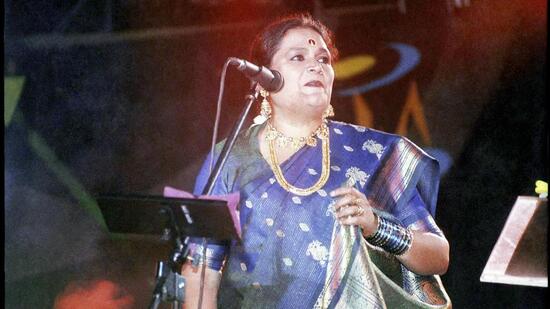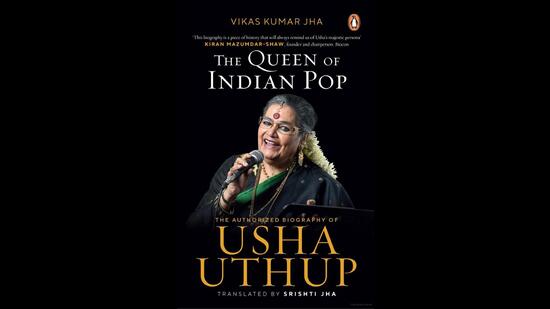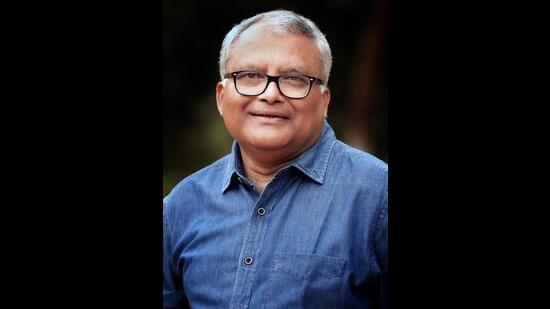Review: The Queen Of Indian Pop by Vikas Kumar Jha
While fans know Usha Uthup for her stage presence and distinct style of singing, her biography presents the personality behind the music
She was barely 20 when she appeared at Chennai’s Nine Gems nightclub on a rainy June evening, dazzling the audience with the popular song ‘Fever’. She was “wearing a green and yellow saree and blouse, ruby-like vermilion/ sindoor on the forehead and light green bangles”. The venue’s owner Yashwant Vikamsi was so impressed that he offered the youngster a regular slot.

Anecdotes like this make Usha Uthup’s biography an engrossing read. Originally written in Hindi by Vikas Kumar Jha, The Queen Of Indian Pop: The Authorized Biography Of Usha Uthup has now been translated to English by his daughter Srishti Jha. Over 29 chapters, we read about Uthup, one of popular Indian music’s big success stories, growing from someone who never thought of taking up music as a career to becoming someone who drew packed concerts everywhere.

Usha’s forte has been in her live performance. Interacting regularly with her audience, she has chosen songs as per their mood. But there are other aspects of her life that this book brings out, both personal and musical. Her growing up in a police officer’s family in Byculla, Bombay, her first marriage to Ramu Iyer and her second one to Jani Chacko Uthup are described in adequate detail while her Hindi film music and jingle experiences are narrated with stories and trivia.
The first few chapters are about Usha’s family and upbringing. An entire chapter Bombay Police’s Sherlock Holmes is on her father Vaidyanath Someshwar Sami, and then there is one on her elder sisters Indira and Uma, who sang English songs as the Sami Sisters. Usha’s maternal home in Chennai was always bubbling with music, literature and activity. According to the book, “The three floors were gleefully lost in different genres of music. One resounded with Western music, the melodies of Bach, Beethoven and Mozart; the other echoed with north Indian classical music featuring iconic names like (Bade) Ghulam Ali Khan, Pandit Mallikarjun Mansur and Pandit Bhimsen Joshi; the third floor was reserved for south Indian classical with MS Subbulakshmi’s voice kissing the tears of the heart.” With her eldest maternal uncle Balram Nadhan dancing to popular western music, young Usha was simultaneously exposed to that form too.
Early on in her career, Usha was known for her performances at Nine Gems and Hotel Savera in Chennai, and at Little Hut and Talk Of The Town in Mumbai. But the venue most often associated with her is Trincas in Park Street, Kolkata. While she regaled audiences with Beatles hits like A Hard Day’s Night and Yesterday, and Jose Feliciano’s Rain, it was here that Jani Uthup first requested her to sing Harry Belafonte’s Matilda. Though Belafonte and Frank Sinatra had been her favourite singers, she wasn’t prepared for this, and promised to sing it the following Monday.
On the film music front, there’s an interesting incident involving Dum Maro Dum, RD Burman’s song in Dev Anand’s Hare Rama Hare Krishna (1971). In fact, Dev had approached Usha to sing for Zeenat Aman, saying that Lata Mangeshkar would sing for Mumtaz. She was thus given the lines of Dum Maro Dum to rehearse. Burman later informed her that Asha Bhosle would be singing that song, and she would get I Love You, which turned out to be a duet with Asha. Burman, however, gave her the English medley in Bombay To Goa, where she appeared on screen. In the early 1980s, she had a string of hits like Ramba Ho, Hari Om Hari and Koi Yahaan Nache Nache with music director Bappi Lahiri and Shaan Se with Burman.
After they got married, Jani and Usha lived in Cochin for a few years. When they returned to Calcutta, the singer was welcomed back to Trincas, and she enjoyed her second innings. But she noticed that the live scene had changed, as with the increase in entertainment tax rates, fewer bands were playing at clubs. Usha took to recording music. This wouldn’t be restricted to the film domain but included private recordings too and gave her immense satisfaction.

The book is written at a measured pace with anecdotes and descriptions of events. These include her radically different experiences with politicians. While Indira Gandhi presented Usha with a shawl because the weather was cold, West Bengal public works department minister Jatin Chakraborty prevented her show accusing her of “promoting a decadent kind of culture”.
There is also mention of her biggest shortcoming – her inability to immediately say “no” to anyone: “She trusts every relationship blindly, till the other person betrays her trust and leaves. Usha says that although she looks very powerful from the outside, she is quite fragile within. She was always afraid of the dark. That is the reason why she cannot sleep in her room with the lights turned off.”
Nuggets like these make The Queen Of Indian Pop an interesting read. Many fans know Usha for her sarees, her charming stage presence and her distinct style of singing, but this book offers much more. It goes deep within the personality behind the music.
Narendra Kusnur is a veteran music journalist.
All Access.
One Subscription.
Get 360° coverage—from daily headlines
to 100 year archives.



HT App & Website






